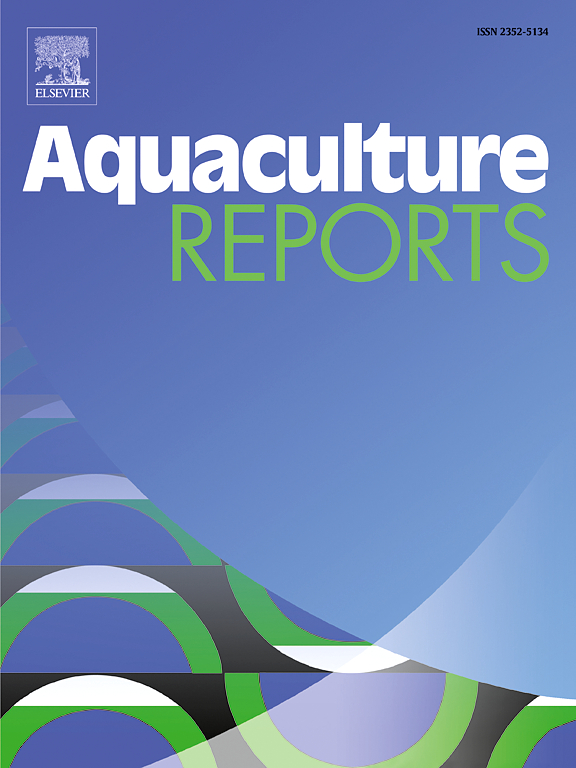Dietary mixtures of Bacillus spp. modulates intestinal morphology, resistance to Vibrio parahaemolyticus, response of immune-antioxidant genes, and growth of Dicentrarchus labrax
IF 3.7
2区 农林科学
Q1 FISHERIES
引用次数: 0
Abstract
Probiotics including Bacillus spp. are gaining a lot of interest in fish diets due to their distinctive pharmacological and nutritional value. To look at the impact of dietary fortification of a mixture of Bacillus spp. (MBs), a 56-day feeding trial was applied to European seabass (Dicentrarchus labrax). The evaluation addressed the influence on growth, absorption, hematology, biochemical, and immune-antioxidant response including molecular level. The resistance to Vibrio parahaemolyticus was also assessed. Five treatments having 225 fish (45 fish/treatment; three triplicates/treatment; 15 fish/replicate) were randomly assigned (8.00 ± 0.30 g body weight). The MBs were included in the basal diet at 0 (control), 1(MBs1), 2 (MBs2); 3 (MBs3); and 4 (MBs4) g/kg diet and given to the fish for 56 days. The results displayed that MBs-supplemented diets notably augmented growth (weight gain and specific growth rate) and intestinal morphology (villous length and width). The highest results for weight gain, specific growth rate, villous length and width were in the MBs3 (1.32-, 1.16-, 1.68-, and 1.45-fold) and MBs4 (1.33-, 1.17-, 1.78-, and 1.54-fold) groups, respectively, relative to the control. Dietary MBs (1–4 g/kg) significantly improved (P < 0.05) hematological [white blood cells count (1.12-fold), hematocrit (1.01-, 1.01-, 1.02-, and 1.04-fold), and hemoglobin (1.02-, 1.03-, 1.05-, and 1.06-fold)] and biochemical indices [albumin (1.05-, 1.08-, 1.11-, and 1.08-fold), globulin (1.13-, 1.24-, 1.46-, and 1.48-fold), total protein (1.09-, 1.16-, 1.29-, and 1.29-fold), and triglycerides (1.00-, 1.00-, 1.00-, and 1.01-fold)]. The antioxidant indices as catalase (1.15-, 1.15-, 1.16-, and 1.16-fold), superoxide dismutase (SOD; 1.06-, 1.09-, 1.10-, and 1.09-fold), and glutathione peroxidase (GPx; 1.02-, 1.10-, 1.11-, and 1.10-fold) were enhanced by dietary MBs (1–4 g/kg), respectively, compared with the control. The aspartate (0.98-, 0.98-, 0.97-, and 0.97-fold) and alanine (0.96-, 0.93-, 0.89-, and 0.89-fold) aminotransferases, alkaline phosphatase (0.97-fold), glucose (0.96-, 0.95-, 0.93-, and 0.93-fold), cholesterol (0.88-fold), and malondialdehyde (0.92-, 0.90-, 0.91-, and 0.91-fold) were declined by dietary MBs supplementation (1–4 g/kg), respectively. Moreover, the expression of growth [insulin-like growth factor 1 (1.41-, 1.91-, 2.15-, and 2.65-fold) and growth hormone (1.67-, 1.97-, 2.25-, and 2.72-fold)] and immuno-antioxidant associated genes [complement3 (1.42-, 1.95-, 2.33-, and 2.52-fold), interleukin-1 beta (1.30-, 1.76-, 2.43, and 2.82-fold), SOD (1.40-, 1.86-, 2.47-, and 2.64-fold), and GPx (1.22-, 1.75-, 2.55-, and 2.75-fold)] were up-regulated in MBs-fed groups (1–4 g/kg), respectively. Post-challenge with V. parahaemolyticus, the MBs3 and MBs4 groups had the highest survival rate (70.00 and 70.00 %), followed by the MBs2 group (60.00 %) and MBs1 group (50.00 %) compared to control (30.00 %). Depending on the broken line regression approach, our study suggests using dietary MBs at an optimal level of 3 g/kg diet. From overall results, MBs (3 g/kg diet) are recommended in European seabass to promote growth rate, feed utilization, immune-antioxidant status, and V. parahaemolyticus resistance without any hazardous impact on liver functions. These advantageous gains may help to ensure a sustainable aquaculture.
饲粮中添加芽孢杆菌可调节肠道形态、对副溶血性弧菌的抗性、免疫抗氧化基因的反应和双颌口参的生长
包括芽孢杆菌在内的益生菌由于其独特的药理和营养价值而在鱼类饲料中获得了很大的兴趣。为了研究在饲料中添加混合芽孢杆菌(Bacillus spp., MBs)的影响,对欧洲鲈鱼(Dicentrarchus labrax)进行了为期56天的饲养试验。评价涉及对生长、吸收、血液学、生化和免疫抗氧化反应的影响,包括分子水平。对副溶血性弧菌的耐药性也进行了评估。5个处理共225条鱼(45条鱼/处理;三个一式三份/治疗;15尾鱼/重复)随机分配(8.00 ± 0.30 g体重)。分别在0(对照)、1(MBs1)、2 (MBs2)时加入基础饲粮;3 (MBs3);4 (mb4) g/kg饲料,饲喂56 d。结果表明:饲粮中添加mbs显著提高了仔猪的生长(增重和特定生长率)和肠道形态(绒毛长度和宽度)。在增重、特定生长率、绒毛长度和宽度方面,MBs3组(1.32、1.16、1.68和1.45倍)和MBs4组(1.33、1.17、1.78和1.54倍)分别较对照组显著提高。饲粮添加mb(1 ~ 4 g/kg)显著改善了血液学指标[白细胞计数(1.12倍)、红细胞压积(1.01、1.01、1.02和1.04倍),血红蛋白(1.02、1.03、1.05和1.06倍)]和生化指标[白蛋白(1.05、1.08、1.11和1.08倍)、球蛋白(1.13、1.24、1.46和1.48倍)、总蛋白(1.09、1.16、1.29和1.29倍)和甘油三酯(1.00、1.00、1.00和1.01倍)](P <; 0.05)。抗氧化指标为过氧化氢酶(1.15-、1.15-、1.16-和1.16倍)、超氧化物歧化酶(SOD;1.06-, 1.09-, 1.10-和1.09倍),谷胱甘肽过氧化物酶(GPx;与对照组相比,饲粮中添加1-4 g/kg的牛磺酸分别提高了1.02倍、1.10倍、1.11倍和1.10倍的肥力。饲粮中添加1-4 g/kg的牛磺酸分别降低了天冬氨酸(0.98-、0.98-、0.97-和0.97倍)、丙氨酸(0.96-、0.93-、0.89-和0.89倍)转氨酶、碱性磷酸酶(0.97倍)、葡萄糖(0.96-、0.95-、0.93-和0.93倍)、胆固醇(0.88-)和丙二醛(0.92-、0.90-、0.91-和0.91倍)的含量。此外,生长[胰岛素样生长因子1(1.41-、1.91-、2.15-和2.65倍)和生长激素(1.67-、1.97-、2.25-和2.72倍)]和免疫抗氧化相关基因[互补3(1.42-、1.95-、2.33-和2.52倍)]、白细胞介素-1 β(1.30-、1.76-、2.43 -和2.82倍)、超氧化物歧化酶(1.40-、1.86-、2.47-和2.64倍)和GPx(1.22-、1.75-、2.55-和2.75倍)]的表达在mmb喂养组(1 - 4 g/kg)中分别上调。副溶血性弧菌攻毒后,MBs3组和MBs4组的存活率最高(分别为70.00和70.00 %),其次是MBs2组(60.00 %)和MBs1组(50.00 %),对照组(30.00 %)。根据折线回归方法,我们的研究建议以3 g/kg日粮的最佳水平使用日粮中mb。综上所述,推荐在欧洲鲈鱼中添加MBs(3 g/kg日粮)可提高其生长率、饲料利用率、免疫抗氧化能力和对副溶血性弧菌的抵抗力,且不会对肝功能产生有害影响。这些有利的收获可能有助于确保可持续的水产养殖。
本文章由计算机程序翻译,如有差异,请以英文原文为准。
求助全文
约1分钟内获得全文
求助全文
来源期刊

Aquaculture Reports
Agricultural and Biological Sciences-Animal Science and Zoology
CiteScore
5.90
自引率
8.10%
发文量
469
审稿时长
77 days
期刊介绍:
Aquaculture Reports will publish original research papers and reviews documenting outstanding science with a regional context and focus, answering the need for high quality information on novel species, systems and regions in emerging areas of aquaculture research and development, such as integrated multi-trophic aquaculture, urban aquaculture, ornamental, unfed aquaculture, offshore aquaculture and others. Papers having industry research as priority and encompassing product development research or current industry practice are encouraged.
 求助内容:
求助内容: 应助结果提醒方式:
应助结果提醒方式:


